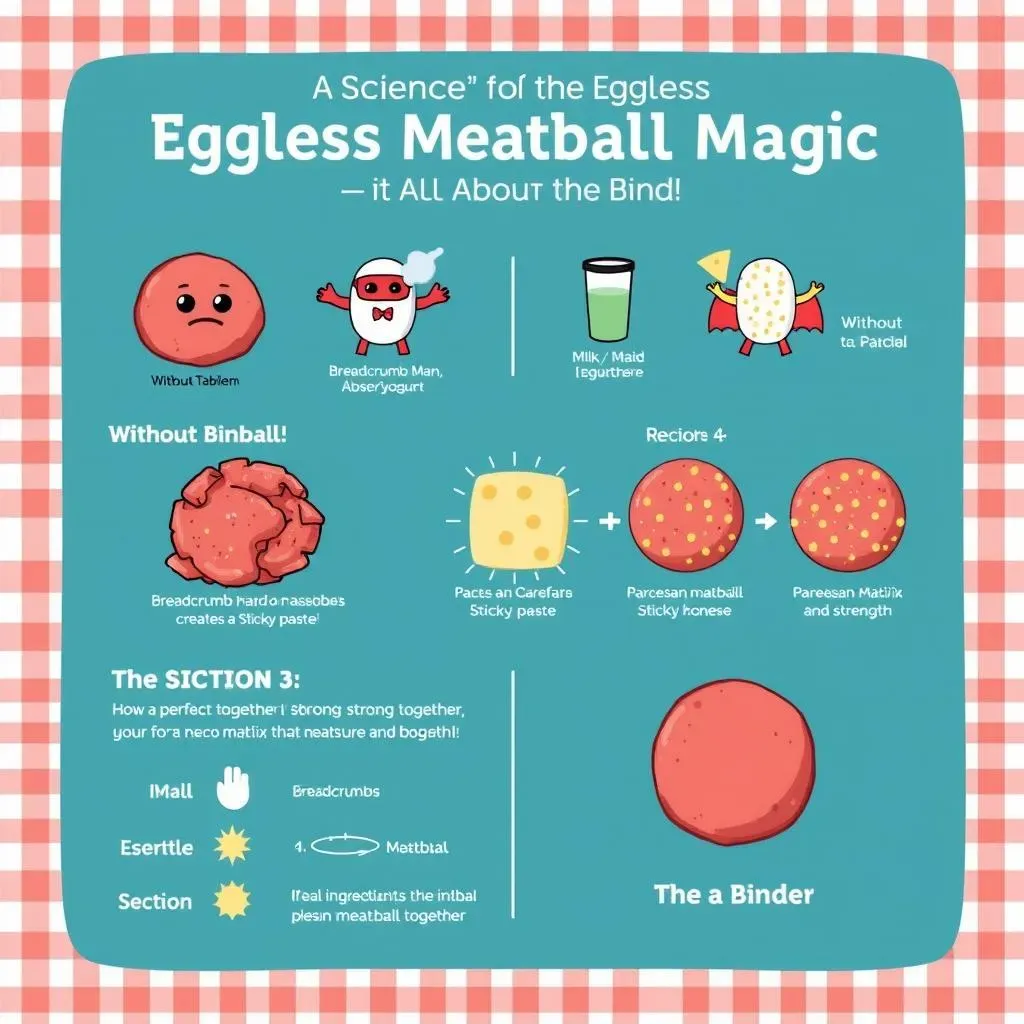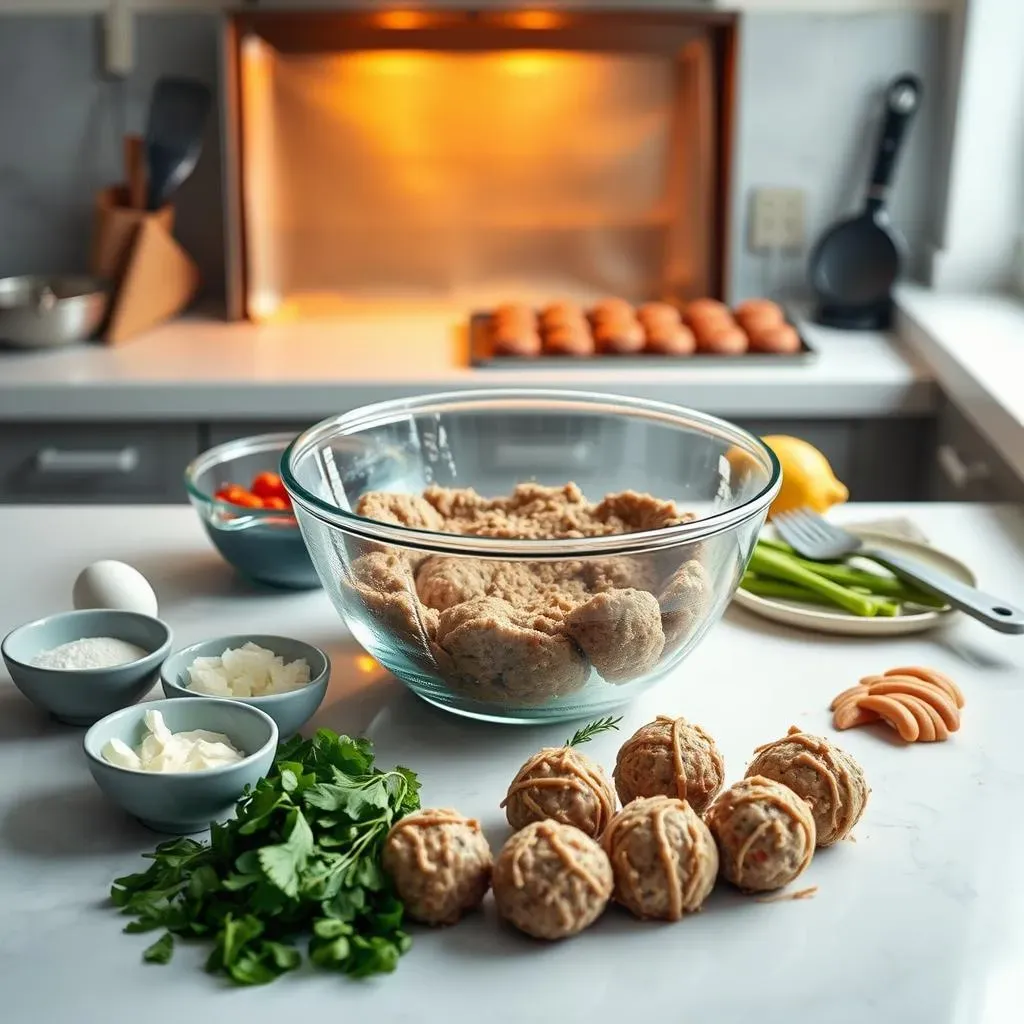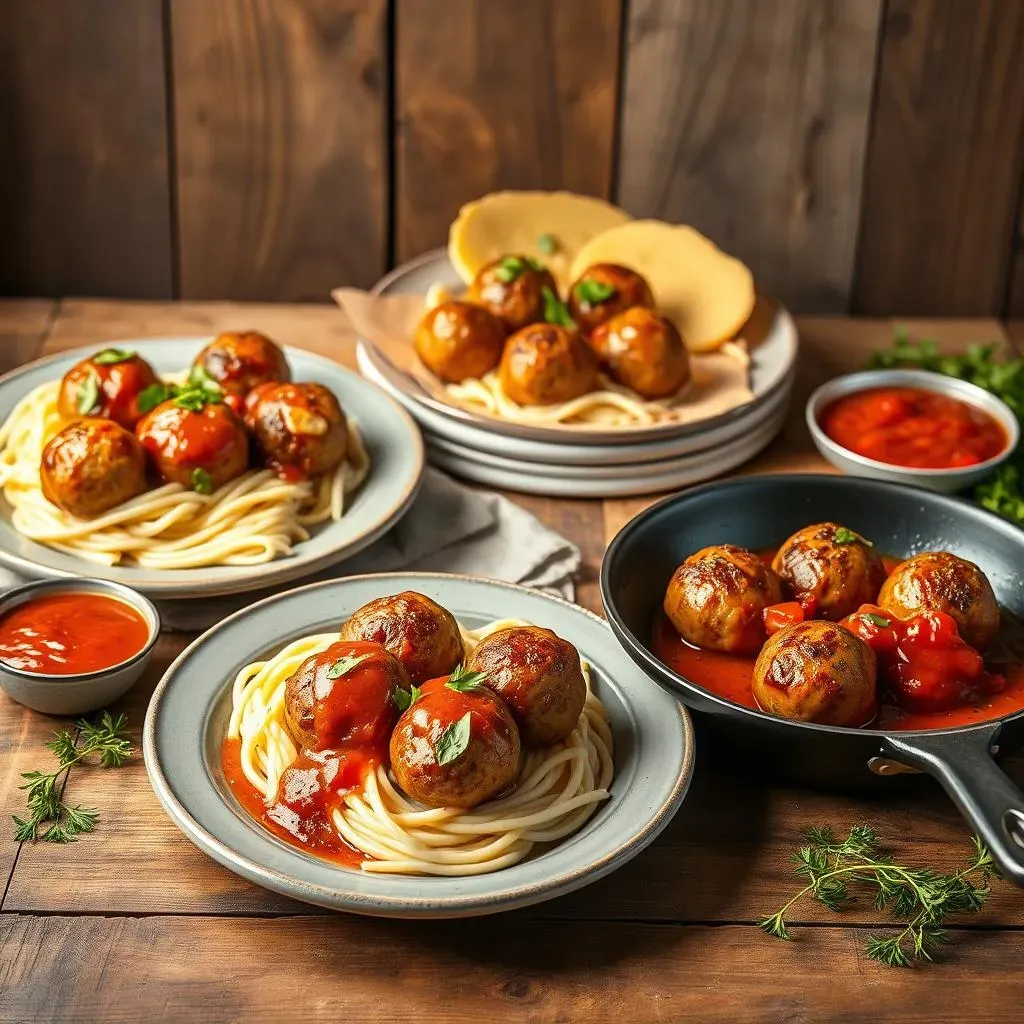Ever found yourself ready to make a delicious batch of meatballs, only to realize you're fresh out of eggs? It's a kitchen bummer, I know. But don't worry, you can still enjoy those juicy, flavorful meatballs without them. This article is your guide to making an easy meatball recipe without egg, and it’s simpler than you might think. We'll explore why eggs are typically included in meatball recipes and what magical ingredients can replace them to ensure your meatballs stick together perfectly. I'll walk you through a straightforward, step-by-step recipe that even a beginner can nail. Plus, I'll cover three different ways you can cook these little wonders – baking, broiling, and pan-searing – so you can choose what works best for you. Get ready to learn everything you need to know about making perfect, egg-free meatballs. It’s time to get cooking!
Why Eggs Usually End Up in Meatballs

Why Eggs Usually End Up in Meatballs
The Binding Power of Eggs
You know, when you’re making meatballs, it’s all about getting them to stick together. That's where eggs usually come in. They act like a glue, holding all the ground meat, breadcrumbs, and seasonings together. The proteins in eggs are amazing at this; they coagulate when heated, creating a network that keeps your meatball from falling apart into a meaty mess. Think of it like the scaffolding that holds up a building; without it, everything would just crumble. It's why so many traditional recipes call for them.
Without eggs, your meatballs might turn into a pile of loose meat. It’s not pretty, and it certainly doesn't make for a good eating experience. The egg's job isn't just about sticking things together, though. It also adds a bit of moisture to the mixture. This keeps the meatballs tender and juicy, not dry and tough. So, eggs are kind of a double whammy—binder and tenderizer all in one. They’re a pretty handy ingredient, but they aren’t essential. We can totally make great meatballs without them, believe it or not.
The Egg's Role: A Quick Look
Function | How It Works |
|---|---|
Binding | Proteins coagulate when heated, creating a network |
Moisture | Adds liquid to keep meatballs tender |
Beyond the Basics
It's not just about structure and moisture; eggs also contribute a little bit of richness to the flavor. They aren’t the main flavor player, but they subtly add to the overall taste. This is why some chefs swear by using them. They make the meatball experience more complete. But, here’s the thing: we’re not trying to make just okay meatballs, we are aiming for delicious ones, and it's totally possible without eggs. So, while eggs are great, they’re not the only way to achieve that perfect meatball texture. We've got some tricks up our sleeves.
Think about it, a good meatball recipe should be flexible, right? If you’re out of eggs, or maybe you’re allergic, you shouldn't have to give up on meatballs altogether. That’s where understanding the egg’s role becomes super important. We can find other ingredients to do the same job, and it’s actually pretty fun to experiment and see what works. So, let’s move on to what can replace them and keep those meatballs together!
What Makes Eggless Meatballs Stick Together?

What Makes Eggless Meatballs Stick Together?
The Magic of Binders
Okay, so we've established that eggs are the usual suspects for keeping meatballs from falling apart. But what if you're egg-free? Don't worry; there are other ways to make sure your meatballs hold their shape. The key is to find the right binders. Think of it like this: instead of relying on eggs, we're going to use a combination of ingredients that work together to create the same effect. Breadcrumbs are a great start, they act like sponges, soaking up moisture and helping to bind the meat together. It’s not just any breadcrumbs, though, plain ones work best for this. And it’s not just about the solids; we need some liquid too, which is where milk, yogurt, or even a bit of broth comes in. This combo creates a sort of paste that holds the meatball together.
It’s all about balance. Too much of one thing, and your meatballs might be too dry or too mushy. The right amount of breadcrumbs will soak up moisture from the meat and the added liquids, creating a nice, firm texture. And the liquids are essential, they help to distribute the moisture evenly, ensuring that the meatballs are tender and don't dry out while they cook. It's like making a mini-cement mix, but for deliciousness. We're not just throwing ingredients together; we're creating a matrix that holds everything in place. So, you see, the egg isn’t the only way to achieve great meatball structure. We just need to be smart about what we use instead.
Key Ingredients for Eggless Binding
- Breadcrumbs: Act like a sponge, soaking up moisture and binding the mixture.
- Milk/Yogurt/Broth: Add moisture and help create a paste-like consistency.
- Parmesan Cheese: Contributes to binding and adds flavor.
The Importance of Moisture
Another thing to keep in mind is the moisture level. If the mixture is too dry, your meatballs will crumble. The liquids help keep everything moist and make the meatballs tender. You can adjust the amount of liquid to get the right consistency. A good rule of thumb is that the mixture should feel moist but not wet. It should hold together when you gently squeeze it in your hand. If it’s too dry, add a little more liquid, a tablespoon at a time. If it’s too wet, add a bit more breadcrumbs. It’s all about finding that sweet spot where everything just comes together. So, while eggs have their purpose, they're not the only way to get that perfect meatball consistency. We're masters of the meatball craft, and we can adapt to any ingredient challenge!
Think of it like building with LEGOs, you need the right pieces to fit together and stay together. In this case, our breadcrumbs, liquids, and other binders are our LEGO pieces, creating a strong and delicious meatball that stands on its own. And let’s not forget the cheese! Parmesan cheese also plays a role in binding, plus it adds a wonderful flavor. So, when you're making eggless meatballs, remember it's all about the right combination and the right balance. It's about understanding how each ingredient works together to create a fantastic final product. Now that we have the secrets to binding, let's get into the actual recipe!
Easy Meatball Recipe Without Egg: StepbyStep

Easy Meatball Recipe Without Egg: StepbyStep
Get Your Ingredients Ready
Alright, let's dive into making these egg-free meatballs. First, you'll need to gather all your ingredients. This is like preparing your tools before starting a project; it makes everything smoother. For this recipe, we're using one pound of ground beef, but you can mix it up with ground pork or turkey if you like. You'll also need half a cup of plain breadcrumbs, a quarter cup of milk (or yogurt, if you prefer), a quarter cup of grated Parmesan cheese, and a quarter cup of finely chopped onion. Don't forget two minced cloves of garlic, about two tablespoons of fresh parsley, a teaspoon of Worcestershire sauce, and some salt and pepper to taste. Having everything measured out and ready to go will make the mixing process a breeze.
I like to use a big bowl for this, something that gives you plenty of room to mix everything together without making a mess. It's also a good idea to have a baking sheet lined with parchment paper ready, so you can transfer the meatballs easily without them sticking. Think of it like setting up your workstation. You wouldn't start building a house without all your materials at hand, would you? Same goes for cooking, having everything prepped makes cooking more fun and less stressful. Trust me, this little bit of preparation will save you a lot of time and headaches in the long run. Now that we have all our ingredients at the ready let's get our hands dirty.
Mixing It All Together
Now for the fun part – mixing all the ingredients! Gently combine the ground meat, breadcrumbs, milk (or yogurt), Parmesan cheese, chopped onion, minced garlic, parsley, Worcestershire sauce, salt, and pepper in your large bowl. Use your hands for this, it's the best way to get everything evenly mixed. Don't overmix the meatball mixture though, just combine everything until it’s just incorporated. Overmixing can make your meatballs tough, and we want them tender and juicy. It's like kneading bread; you want to mix it until everything is just combined, but not more than that.
Once everything is mixed, take a small amount of the mixture, about two tablespoons, and roll it into a ball using your hands. Place the formed meatball onto the prepared baking sheet. Repeat this process until all the meat mixture is used up. You should end up with about 24 meatballs, give or take. Remember, they don't have to be perfectly round, a little bit of variation gives them a rustic look. This step is like shaping clay; you're taking a formless mass and giving it a defined shape. It's where the magic really starts to happen. And now that we have all our meatballs formed, it's time to cook these little gems.
Ingredient | Quantity |
|---|---|
Ground Beef | 1 pound |
Plain Breadcrumbs | 1/2 cup |
Milk (or Yogurt) | 1/4 cup |
Parmesan Cheese | 1/4 cup |
Onion (chopped) | 1/4 cup |
Garlic (minced) | 2 cloves |
Parsley (chopped) | 2 tablespoons |
Worcestershire Sauce | 1 teaspoon |
Salt and Pepper | To Taste |
Ready to Cook
With all the meatballs formed and ready, it's time to decide how you want to cook them. There are three main ways to cook meatballs: baking, broiling, and pan-searing. Each method gives a slightly different result, so it's all about what you prefer. Baking is great because it's hands-off and cooks the meatballs evenly, broiling gives you a nice crispy top, and pan-searing is fantastic for developing a rich, browned crust. We'll talk about each method in the next section. For now, just know that your meatballs are ready to go. It's like finishing all the prep work and getting ready to start the main event. And with that, we've completed the mixing process, and now we move to the final stage – cooking. You are on the home stretch!
Cooking Your EggFree Meatballs: Three Ways

Cooking Your EggFree Meatballs: Three Ways
Baking: The Hands-Off Approach
Okay, let's talk about baking your egg-free meatballs. This method is super convenient because you can pop them in the oven and let them do their thing while you focus on other tasks, like making a killer pasta sauce. Preheat your oven to 400°F (200°C), and place the meatballs on a baking sheet lined with parchment paper. I like to give them a little space so they can cook evenly. Bake them for about 20 to 25 minutes, or until they're golden brown and cooked through. The internal temperature should reach 165°F (74°C) to ensure they're safe to eat. Baking is a great option if you’re cooking for a crowd or just prefer a more hands-off approach. It's like having a personal chef in your oven, doing all the work for you. And the best part? They come out perfectly cooked every time, making it a reliable choice for any meal.
Baking is not only convenient but also helps to keep the meatballs moist because they are cooked in their own juices. This method also allows the flavors to meld together beautifully, creating a really delicious end result. I often use this method when I'm making a big batch of meatballs for meal prep during the week. It saves me time and effort, and I know that I'm always going to have some delicious and healthy meatballs ready to go. And if you are feeling fancy you can always do a little bit of broiling at the end of the baking to make it crispy, the best of both worlds. Now, let's move on to the next method – broiling.
Broiling: For a Crispy Crust
Next up is broiling, which is perfect if you love a crispy, browned exterior on your meatballs. It's like giving your meatballs a little tan! The key here is to keep a close eye on them, as they can go from perfectly browned to burnt in a matter of minutes. Set your oven to broil and place the meatballs on a baking sheet about 4-6 inches from the broiler. Broil for about 5 to 7 minutes, then flip them and broil for another 5 to 7 minutes on the other side. You want them to be nicely browned and cooked through. Broiling is a faster method than baking, but it requires a bit more attention. It's like being a lifeguard, you have to keep a watchful eye to make sure everything is going smoothly. But the result is so worth it – a wonderfully crispy crust that adds a great texture to each bite.
The high heat from the broiler also helps to seal in the juices, keeping the meatballs nice and tender on the inside. I love using this method when I want to add a little extra oomph to my meatballs. The crispy edges make them perfect for serving in a sandwich or over a salad. And if you're looking for a quick and easy way to cook your meatballs, broiling is a fantastic option. It’s like giving your meatballs a quick sear without using a pan. It's all about speed and flavor, and broiling delivers on both fronts. Now, let's explore our final cooking method – pan-searing.
Pan-Searing: The Flavor Booster
Lastly, we have pan-searing, which is my personal favorite for developing a deep, rich flavor. It’s like giving your meatballs a spa day in a hot pan. Heat a tablespoon of olive oil in a large skillet over medium-high heat. Once the oil is hot, add the meatballs and sear them on all sides until they are nicely browned. This should take about 8 to 10 minutes. Then, reduce the heat to low, cover the skillet, and let them cook for another 10 to 15 minutes, or until they are cooked through. Pan-searing is a little more hands-on, but the flavor you get is unparalleled. It’s like building flavor layer by layer, creating a complex and delicious result.
The browning process, also known as the Maillard reaction, is what gives the meatballs that incredible depth of flavor. It's like caramelizing onions, but for meatballs. The browned bits on the bottom of the pan also add extra flavor to your sauce if you decide to cook them in one. I often use this method when I'm making a sauce that I want to be extra flavorful. The pan-seared meatballs add so much richness, and it elevates the dish to a whole new level. So, there you have it, three different ways to cook your egg-free meatballs. Each method has its own unique benefits, so it’s all about choosing what works best for you. It's like having three different superpowers, each with its own strengths. Now, let's move on to some frequently asked questions about making these delicious meatballs.
Cooking Methods Comparison
Method | Pros | Cons |
|---|---|---|
Baking | Hands-off, even cooking | May not get as crispy |
Broiling | Crispy exterior, quick | Requires close attention |
Pan-Searing | Rich flavor, browned crust | More hands-on |